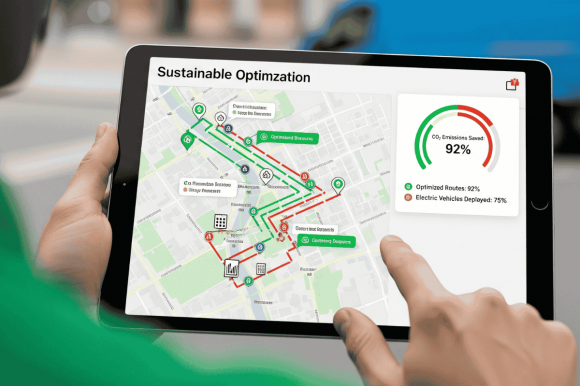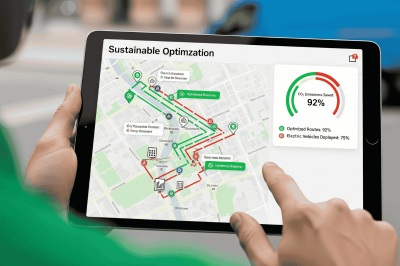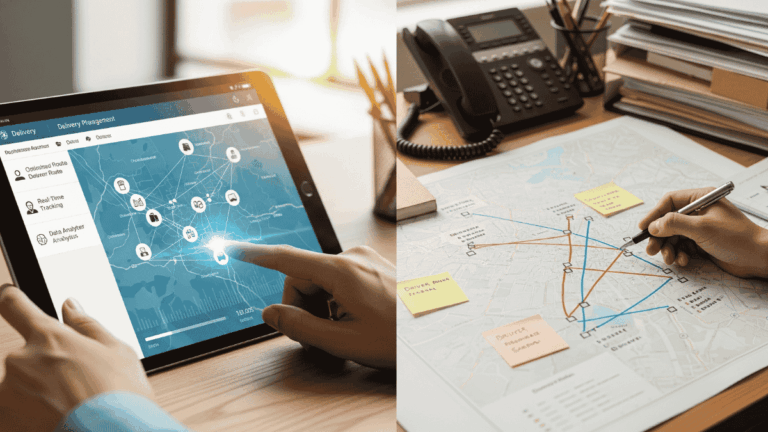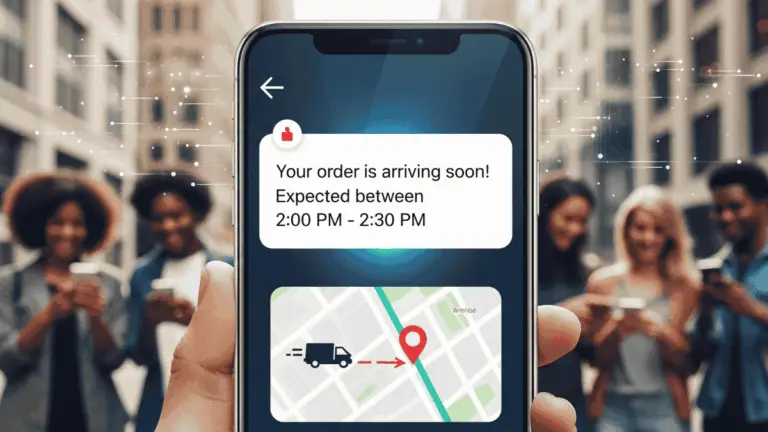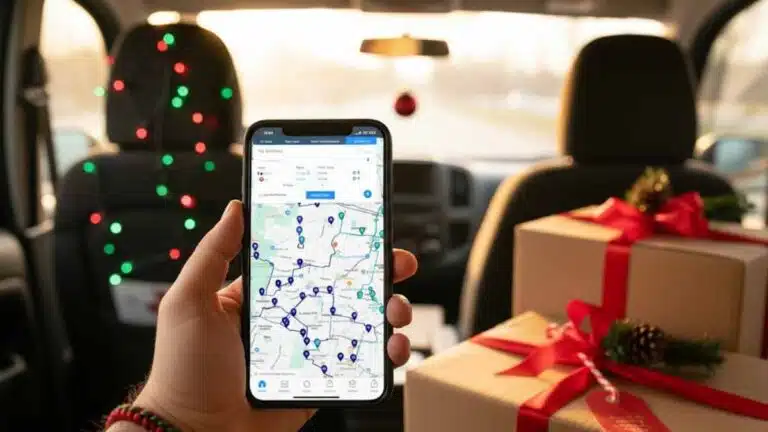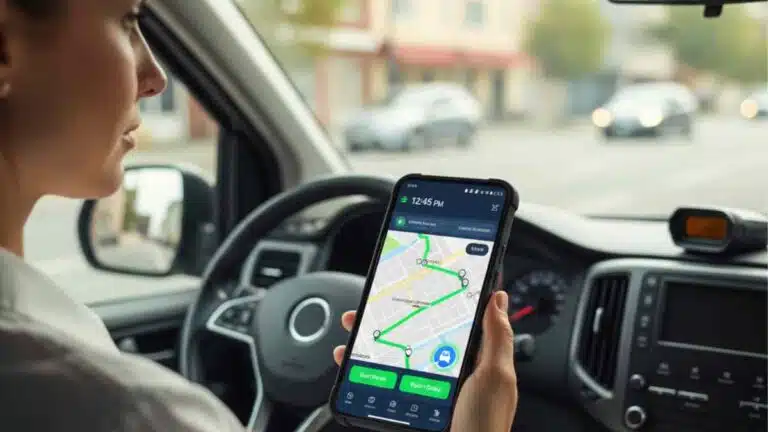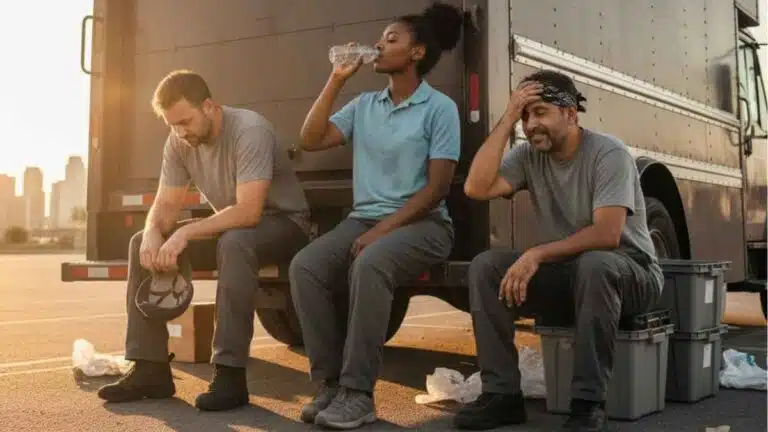Managing rising delivery volumes on tight budgets isn’t always easy. Especially when you’re also expected to lower your carbon footprint! But the good news is you don’t have to choose between speed and sustainability. Route optimization software helps with both.
Modern route optimization helps drivers to cut down of fuel consumption and carbon emissions while maintaining (and let’s be honest, often improving) delivery speed.
In this guide, we’ll take a look at exactly how it does that, and how you can optimize your delivery process without destroying the planet.
If you’re completely new to this field, we’ll start with the basics: What is route optimization and how it works. Feel free to skip right to the guide by clicking here.
What is route optimization software
In the simplest of terms, route optimization software calculates the most efficient delivery routes for a fleet. That’s it!
But the benefits include lower fuel costs, more efficient deliveries, better use of your fleets and vehicles’ capacity, and happier customers.
The software optimizes routes by factoring in delivery windows, service durations, driver hours, vehicle capacity, live traffic and even weather conditions to minimize distance and time.
Key route optimization software features:
There are a bevy of features, but the most common and sought-after features are real-time tracking, digital proof of delivery (captured on the go!), and the driver app.
1. Real-time tracking
Real-time tracking shows every vehicle on a live map with current status and next stop. ETAs recalc as traffic shifts, so customers see honest timing instead of static windows. Dispatch gets instant visibility into delays and can act before they snowball.
Share a tracking link and let receivers prepare docks or site access. Fewer gate calls. Fewer missed handovers. Drivers spend less time waiting and more time moving.
Alerts fire at the right moments: pickup confirmed, en route, ETA change, delivered. The timeline stores each event with a timestamp and location. Finance and ops can verify a job in seconds without chasing anyone.
2. Proof of delivery
Proof of delivery locks down the handover. Each job ends with photos, a signature, and a time and location stamp.
The record sits on the job timeline, right next to the ETA history, so anyone can verify what happened without hunting through emails.
Use notes for access details or service outcomes. Barcode scans confirm the right item reached the right person. Disputes fall away, claims move faster, and warranty checks stop wasting time. Finance gets clean evidence for billing and credit control.
3. Driver app
The driver app is the daily command center.
It gives clear turn-by-turn directions, shows the next stop, and surfaces special instructions at the door. Drivers can call or message a contact from inside the job screen instead of juggling phones and maps.
Guided flows reduce missed steps and make proof consistent across the fleet.
Status changes trigger alerts to dispatch and customers, which cuts gate calls and keeps everyone aligned.
How route optimization boosts speed and sustainability
1. Shorter distance and lower fuel use
Think of a driver leaving the depot with a clear plan. No zig-zagging across town and definitely no surprise detours to pick up a stray stop.
The system lines up each address in a clean flow, chooses the right depot to start from, and trims the empty kilometres between runs.
Time windows still hold but you burn less fuel and your footprint shrinks with every route.
2. Real-time response when plans shift
A lane closes or rain slows a freeway to a crawl and suddenly there’s chaos on the roads. With static routes, that’s a bad day! Customers will be fuming, fuming for the late deliveries.
With live routing, the plan adjusts while the van is moving. Stops reshuffle to protect the next promise. Dispatch sees the change on the map and steps in only when needed.
The day keeps its shape without a full rebuild.
3. Better use of vehicles and people
Imagine a route that is tailored specifically to your vans’ capacity and your drivers’ workflows. Neither humans nor vehicles will be pushed past their edge in this scenario.
Why? Because capacity meets demand. Service times match what actually happens at the door, so drivers are not stuck waiting with the clock ticking.
The plan fits the rhythm of the day, which makes shifts calmer and drop counts steadier.
4. Improvement that compounds
Every completed job leaves a trail of truth. You see where idling spikes, where reattempts cluster, and where loading drags.
If you track data and analyze it, you can see which habits or process waste time.
So start by looking at the data and choose one issue to fix. Then the next. And eventually you’ll see that gains stack across weeks until the operation runs cleaner and you start saving money.
5. Stronger sustainability story
Lower fuel use moves your emissions in the right direction. Clean records make reporting simple for audits and ESG updates.
You can also offer green delivery slots to customers who prefer consolidation. Reliable arrivals turn sustainability from a slogan into everyday practice.
6. Real savings without slowing down
Shorter routes cut fuel and wear, while smarter schedules lower overtime.
And when there are clear ETAs, your support lines will be quieter and your support staff less stressed! Because customers know exactly when their items will arrive.
Quick win: Turn on dynamic ETAs and text alerts. Receivers adjust on their side, which prevents missed handovers and repeat trips.
Proof from the field
UPS ORION shows the scale case.
UPS reports annual savings measured in tens of millions of miles and millions of gallons of fuel. That demonstrates what planning can do at volume.
Bulky goods benefit too.
One national retailer grouped heavy items by zone and reduced fleet runs across key metros while keeping same-day promises.
Last-mile e-commerce sees gains with these features!
Live tracking and proof of delivery photos are especially vital for the e-commerce sector. Fewer failed deliveries mean fewer wasted kilometers and calmer support teams.
A practical rollout plan
Step 1: Benchmark your starting point
Collect data on kilometres per stop, fuel spend, idle time, and on-time rates for a few weeks. This becomes your baseline.
Step 2: Centralize the rules
Add delivery windows, service times, driver shifts, and vehicle limits in one place. Accuracy here prevents bad plans later.
Step 3: Feed live inputs
Bring traffic, incidents, and telematics into the system. Live inputs turn a plan into a responsive plan.
Step 4: Enable dynamic ETAs
Share tracking links and allow simple rescheduling. Fewer reattempts means less fuel and fewer headaches.
Step 5: Equip drivers properly
Use a driver app for navigation, updates, and proof of delivery. Make it easy to follow the plan and record outcomes.
Step 6: Compare plan to reality
Review variance daily. Adjust buffer times, loading assumptions, and service durations. Small edits improve results fast.
Step 7: Support the change
Explain the why to drivers and dispatch. Offer green slots to customers who can accept consolidation. Alignment keeps adoption high.
Route optimization: Common traps to avoid
But there are common pit falls to avoid. Take note of these traps:
- Do not chase distance alone. Balance distance with time windows.
- Do not ignore data quality. Bad addresses and missing service times break good plans.
- Do not lock routes too early. Live updates exist for a reason.
- Do not leave customers in the dark. Missed communications create repeat work.
- Do not skip the review loop. Post-route analysis reveals easy wins.
Read this for a deep dive: 14 Costly Customer Experience Mistakes You’ll Avoid With Route Optimization
How Locate2u helps
Locate2u puts planning, tracking, and proof in one place so teams can run delivery days without guesswork.
You plan routes that hit real-time windows, then watch jobs move across the map with honest ETAs. Drivers see clear turn-by-turn directions, update job status as they go, and capture photos or signatures without friction.
The platform also shows what really happened.
You’ll spot idle time, route drift, and missed promises in a single view. That makes it easy to adjust tomorrow’s plan and coach where it matters.
The aim is simple: cut distance and emissions while improving reliability.
FAQs
Does planning for sustainability slow deliveries?
No. Cutting distance and idling usually make deliveries faster.
How do time windows affect results?
Tight windows can add distance. Smart planning balances windows with congestion and travel time.
Do EV fleets benefit from optimization?
Yes. Shorter routes extend range and reduce charging downtime.
Is this only for large fleets?
No. Smaller fleets often see faster payback because they move from manual planning to a smarter baseline.
How soon do results appear?
Many teams see progress within a few weeks once live data and proof capture are in place.
Route optimization for measurable sustainability
If you take away only one nugget from this article, let it be this:
Sustainable logistics is a planning problem. But with strong routing and live tracking (and a power driver app), you deliver faster while still cutting emissions at the same time.
If you want the nuts and bolts, see how route optimization software saves hours in real fleets, so your sustainability gains don’t get erased by preventable rework.
About the author
Cheryl has contributed to various international publications, with a fervor for data and technology. She explores the intersection of emerging tech trends with logistics, focusing on how digital innovations are reshaping industries on a global scale. When she's not dissecting the latest developments in AI-driven innovation and digital solutions, Cheryl can be found gaming, kickboxing, or navigating the novel niches of consumer gadgetry.

